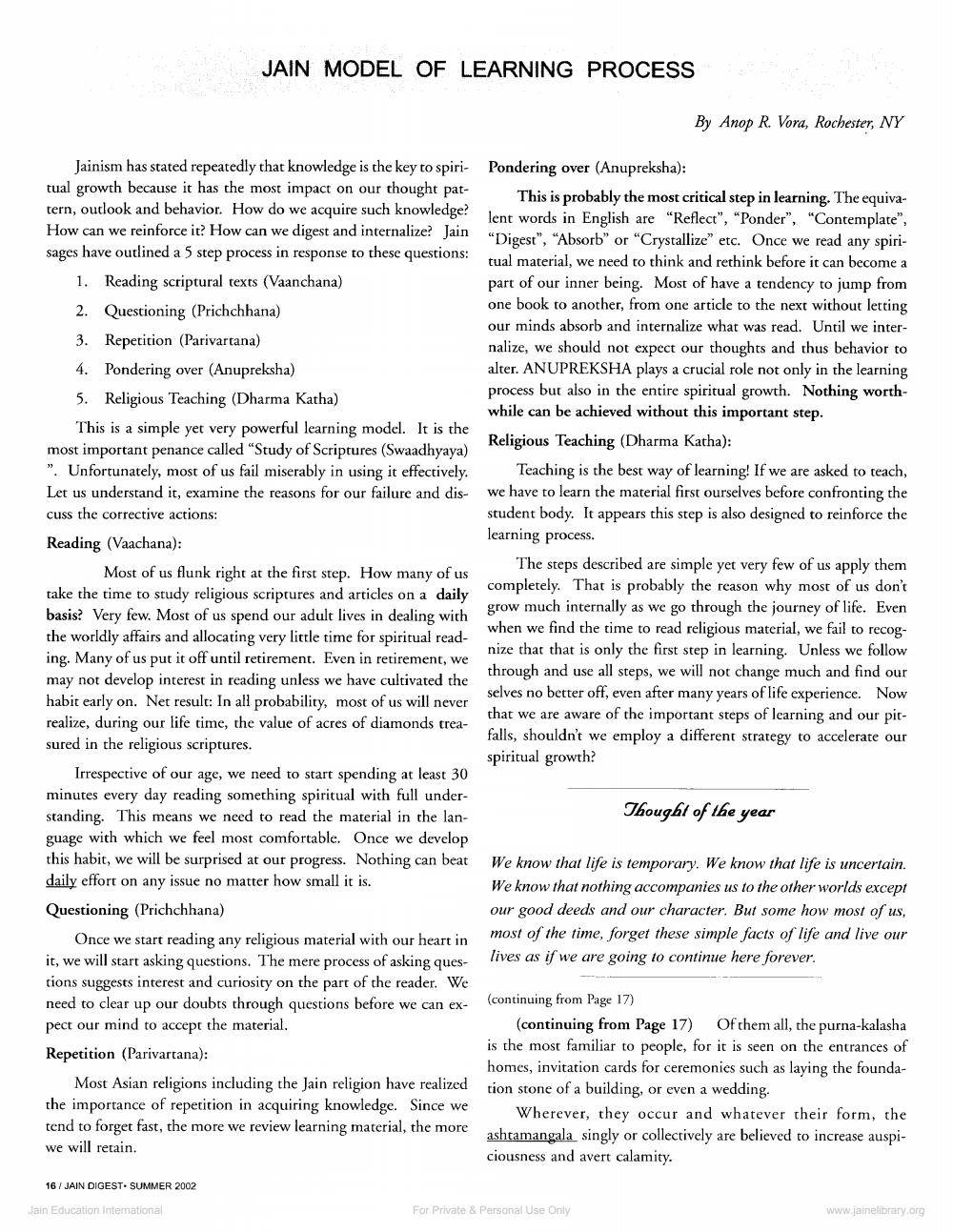________________
JAIN MODEL OF LEARNING PROCESS
By Anop R. Vora, Rochester, NY
Jainism has stated repeatedly that knowledge is the key to spiri- Pondering over (Anupreksha): tual growth because it has the most impact on our thought pat
nt par. This is probably the most critical step in learning. The equivatern, outlook and behavior. How do we acquire such knowledge
wledge lent words in English are "Reflect", "Ponder", "Contemplate",
and How can we reinforce it? How can we digest and internalize? Jain "Digest". "Absorb" or "Crystallize" etc. Once we read any spirisages have outlined a 5 step process in response to these questions:
tual material, we need to think and rethink before it can become a 1. Reading scriptural texts (Vaanchana)
part of our inner being. Most of have a tendency to jump from
one book to another, from one article to the next without letting 2. Questioning (Prichchhana)
our minds absorb and internalize what was read. Until we inter3. Repetition (Parivartana)
nalize, we should not expect our thoughts and thus behavior to 4. Pondering over (Anupreksha)
alter. ANUPREKSHA plays a crucial role not only in the learning 5. Religious Teaching (Dharma Katha)
process but also in the entire spiritual growth. Nothing worth
while can be achieved without this important step. This is a simple yet very powerful learning model. It is the
Religious Teaching (Dharma Katha): most important penance called "Study of Scriptures (Swaadhyaya) ". Unfortunately, most of us fail miserably in using it effectively. Teaching is the best way of learning! If we are asked to teach, Let us understand it, examine the reasons for our failure and dis- we have to learn the material first ourselves before confronting the cuss the corrective actions:
student body. It appears this step is also designed to reinforce the Reading (Vaachana):
learning process. Most of us flunk right at the first step. How many of us
The steps described are simple yet very few of us apply them take the time to study religious scriptures and articles on a daily
completely. That is probably the reason why most of us don't basis? Very few. Most of us spend our adult lives in dealing with
grow much internally as we go through the journey of life. Even the worldly affairs and allocating very little time for spiritual read
when we find the time to read religious material, we fail to recoging. Many of us put it off until retirement. Even in retirement, we
nize that that is only the first step in learning. Unless we follow
through and use all steps, we will not change much and find our may not develop interest in reading unless we have cultivated the habit early on. Net result: In all probability, most of us will never
selves no better off, even after many years of life experience. Now
that we are aware of the important steps of learning and our pirrealize, during our life time, the value of acres of diamonds treasured in the religious scriptures.
falls, shouldn't we employ a different strategy to accelerate our
spiritual growth? Irrespective of our age, we need to start spending at least 30 minutes every day reading something spiritual with full understanding. This means we need to read the material in the lan
Thought of the year guage with which we feel most comfortable. Once we develop this habit, we will be surprised at our progress. Nothing can beat We know that life is temporary. We know that life is uncertain. daily effort on any issue no matter how small it is.
We know that nothing accompanies us to the other worlds except Questioning (Prichchhana)
our good deeds and our character. But some how most of us, Once we start reading any religious material with our heart in most oj the time, Jorget these simple facts of life and live our it, we will start asking questions. The mere process of asking ques
lives as if we are going to continue here forever. tions suggests interest and curiosity on the part of the reader. We need to clear up our doubts through questions before we can ex- continuing from Page 17) pect our mind to accept the material.
(continuing from Page 17) Of them all, the purna-kalasha Repetition (Parivartana):
is the most familiar to people, for it is seen on the entrances of
homes, invitation cards for ceremonies such as laying the foundaMost Asian religions including the Jain religion have realized tion stone of a building, or even a wedding. the importance of repetition in acquiring knowledge. Since we
Wherever, they occur and whatever their form, the tend to forget fast, the more we review learning material, the more
ashtamangala singly or collectively are believed to increase auspiwe will retain
ciousness and avert calamity.
16/JAIN DIGEST. SUMMER 2002
Jain Education Intemational
For Private & Personal use only
www.jainelibrary.org




